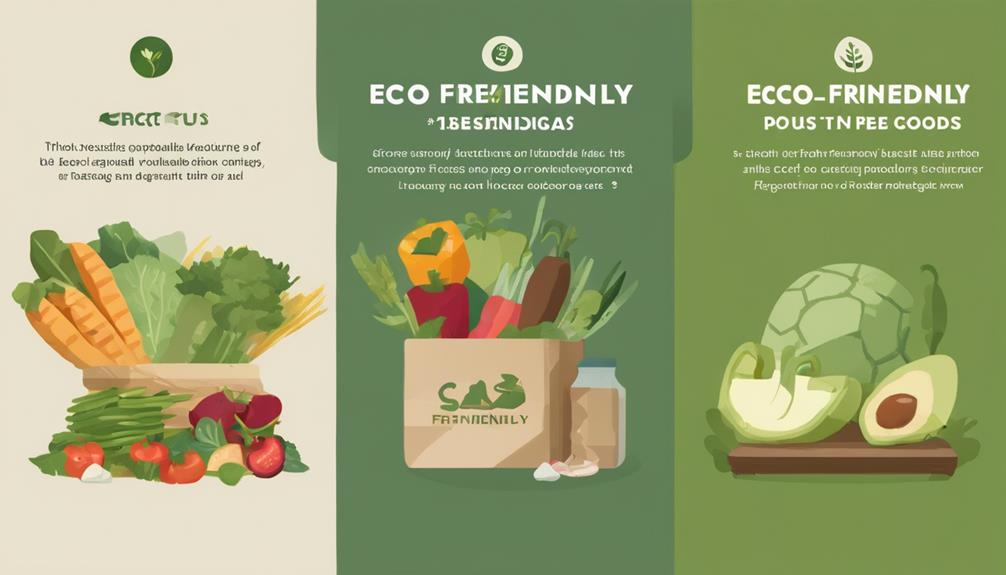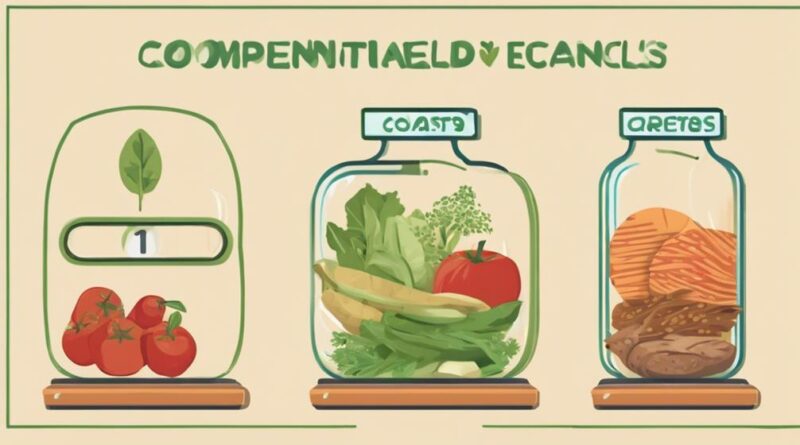What's the Cost Analysis of Eco-friendly Foods?
When assessing the cost analysis of eco-friendly foods, several key factors influence pricing. Organic foods often cost more due to shorter supply chains and stringent regulations. Eco-friendly packaging materials can increase costs, but packaging in smaller quantities helps maintain freshness. Pricing strategies focus on optimizing profitability through strategic approaches and aligning with consumer demand trends. Seasonal dynamics impact costs, with in-season produce offering lower prices. Sustainability efforts in cost management are crucial for organizations focused on eco-friendly practices. Considering sustainability benefits against prices is vital for successful pricing strategies. Explore further for a deeper understanding of eco-friendly food cost analysis.
Factors Affecting Organic Food Costs
When analyzing the costs of organic foods, it's crucial to consider various factors that directly impact their pricing. One significant factor is the supply chain involved in bringing organic products to the market. Organic foods typically have a more complex and shorter supply chain compared to conventional products. This is due to the stringent regulations and certifications required for organic farming and processing. As a result, organic foods often pass through fewer intermediaries, leading to slightly higher initial costs.
Packaging costs also play a vital role in determining the final price of organic foods. Eco-friendly packaging materials are often preferred in the organic food industry to align with the overall sustainable and environmentally conscious ethos of organic farming. While these packaging materials may be more expensive upfront, they contribute to reducing the environmental impact of the products. Additionally, organic foods are sometimes packaged in smaller quantities to maintain freshness and quality, which can slightly increase packaging costs per unit.
Pricing Strategies for Organic Menus
To optimize the profitability of organic menus, strategic pricing approaches must be carefully crafted based on cost analysis and consumer demand trends. When setting prices for organic menu items, it's crucial to consider factors such as menu profitability and organic sourcing. Competitive pricing strategies can be implemented to attract price-sensitive customers while maintaining the value of organic ingredients and sustainable sourcing practices.
In determining the pricing of organic menus, businesses need to conduct a thorough cost analysis that includes the expenses associated with organic sourcing. This analysis should cover not only the direct costs of organic ingredients but also the additional expenses related to sourcing sustainably produced items. By understanding these costs, establishments can set prices that reflect the value of organic sourcing while remaining competitive in the market.
Moreover, pricing strategies for organic menus should align with consumer demand trends. Research shows that there's a growing segment of consumers willing to pay a premium for organic and sustainably sourced foods. By leveraging this trend, businesses can justify slightly higher prices for their organic menu items, increasing profitability while catering to the preferences of environmentally-conscious customers.
Impact of Seasonality on Costs
Considering the fluctuating availability and pricing of seasonal ingredients, understanding their impact on costs is vital for maintaining profitability in organic menus. Seasonal fluctuations play a significant role in the cost analysis of eco-friendly foods. The supply chain dynamics of seasonal ingredients can heavily influence the overall expenses incurred by organic food establishments.
The cost implications of seasonality on organic menus are multi-faceted. When certain ingredients are in season, their abundance typically leads to lower prices due to decreased production costs and transportation expenses. Conversely, out-of-season produce may need to be sourced from distant locations or grown in controlled environments, resulting in higher procurement costs. These fluctuations in ingredient costs directly affect the bottom line of organic food providers.
In addition to direct ingredient costs, supply chain dynamics during different seasons can impact operational expenses. For instance, during peak seasons, increased demand for organic products might lead to higher labor costs or a need for additional storage facilities. Understanding these supply chain dynamics and planning for seasonal fluctuations is crucial for managing costs effectively in eco-friendly food businesses.
Comparing Organic Vs. Conventional
Comparing the costs of organic and conventional ingredients reveals significant disparities in pricing structures and procurement strategies in the eco-friendly food industry. When looking at organic foods, the higher costs are often attributed to the stringent production methods required for organic certification. These methods, though more expensive, offer environmental benefits by reducing the use of synthetic pesticides and fertilizers, promoting soil health, and supporting biodiversity.
On the other hand, conventional foods are typically mass-produced using conventional farming practices that rely heavily on synthetic chemicals. While conventional foods may have lower upfront costs due to economies of scale and higher market demand, they often lack the same level of nutritional value as organic foods. Studies have shown that organic foods tend to have higher levels of essential nutrients and antioxidants, making them a more attractive option for health-conscious consumers.
The market demand for organic foods continues to rise as more consumers become aware of the benefits they offer. This increased demand, coupled with the labor-intensive production methods of organic farming, contributes to the higher price points seen in organic products. Ultimately, the choice between organic and conventional foods boils down to personal preferences regarding health, environmental impact, and budget constraints.
Calculating Return on Investment
Analyzing the return on investment in eco-friendly foods requires a detailed examination of costs and benefits associated with sustainable production methods and consumer preferences. When conducting an ROI calculation for eco-friendly foods, it's crucial to consider both the initial investment required for sustainable practices and the long-term benefits they bring. A comprehensive cost benefit analysis can help determine if the shift towards eco-friendly foods is financially viable for your business.
To calculate the return on investment, start by identifying all costs associated with implementing eco-friendly practices in food production. These costs may include expenses for organic certification, renewable energy sources, sustainable packaging, and fair labor practices. Once the costs are determined, quantify the benefits that come with these investments. These benefits could range from increased consumer trust and loyalty to potential savings from reduced waste and energy consumption.
After gathering the necessary data on costs and benefits, use the following formula to calculate ROI: ROI = (Net Profit / Cost of Investment) x 100. This calculation will provide you with a percentage that indicates the return on investment for your eco-friendly food initiatives. By conducting a thorough ROI analysis and cost benefit assessment, you can make informed decisions about the financial implications of embracing sustainable food production methods.
Cost-saving Techniques in Organic Procurement
Implementing cost-saving techniques in organic procurement involves strategically optimizing purchasing processes to enhance financial efficiency and sustainability. Bulk purchasing is a key strategy in reducing costs when procuring organic foods. By buying in larger quantities, you can often secure discounts from suppliers due to economies of scale. This approach not only helps lower the unit cost of organic products but also minimizes the frequency of ordering, reducing administrative expenses associated with procurement.
Negotiating prices is another critical aspect of cost-saving in organic procurement. When dealing with organic suppliers, don't hesitate to engage in price discussions. Suppliers may be open to offering discounts, especially if you commit to long-term contracts or increase order volumes. Additionally, exploring alternative suppliers and comparing prices can help you identify the most cost-effective options without compromising on organic quality.
Sustainability Efforts in Cost Management

Efficiently managing costs while prioritizing sustainability is essential for organizations seeking to enhance their environmental impact and financial performance in the procurement of eco-friendly foods. Sustainable cost management involves various strategies that can positively impact both the environment and the bottom line. One key aspect where sustainability efforts play a crucial role is within the supply chain. By optimizing transportation routes, reducing energy consumption in warehouses, and working closely with suppliers to ensure ethical and sustainable practices, organizations can minimize costs while reducing their carbon footprint.
Another significant area where sustainability efforts can influence cost management is product packaging. Eco-friendly packaging solutions, such as using recyclable materials or minimizing excess packaging, not only demonstrate a commitment to environmental responsibility but can also result in cost savings. Sustainable packaging initiatives can streamline operations, reduce waste disposal costs, and appeal to environmentally conscious consumers.
Consumer Perception Vs. Price Perception
To understand the impact of consumer perception on pricing strategies for eco-friendly foods, it's crucial to consider the interplay between how customers perceive sustainability efforts and their willingness to pay. When it comes to eco-friendly food products, consumers often weigh the sustainability benefits against the price they're asked to pay. Price comparison plays a significant role in their decision-making process, as they assess whether the added cost of eco-friendly options is justified by the perceived environmental and health benefits.
Market demand for eco-friendly foods is on the rise, driven by increasing awareness of sustainability issues and a growing emphasis on personal health. However, affordability concerns can act as a barrier for some consumers. While many are willing to pay a premium for products they see as contributing to a better environment, others may find the higher prices prohibitive.
Companies that offer eco-friendly foods must navigate this delicate balance between pricing their products competitively and communicating the value of their sustainability efforts. Clear messaging about the benefits of choosing eco-friendly options, such as reduced environmental impact or higher nutritional value, can help justify the higher price point to consumers. Ultimately, understanding consumer perception and price sensitivity is crucial for developing successful pricing strategies in the eco-friendly food market.
Conclusion
In conclusion, when considering the cost analysis of eco-friendly foods, it's important to take into account various factors such as sourcing, seasonality, and consumer perception.
While organic foods may have a higher upfront cost, the long-term benefits of sustainability and health can outweigh the initial investment.
By implementing cost-saving techniques and strategic pricing strategies, businesses can effectively manage the cost of offering eco-friendly menus while appealing to environmentally conscious consumers.
